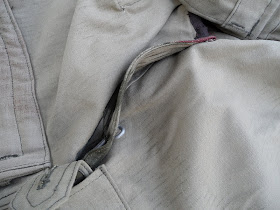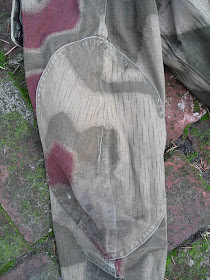Pages
▼
Thursday, November 10, 2011
Bundesgrenzschutz Einsatzjacke, Sumpftarn / Sumpfmuster Camo, BGS Camo Field Jacket, 1971
Todays posting is a 1971, Bundesgrenzschutz Field Jacket in the BGS Sumpftarn / Sumpfmuster camo pattern, These jackets were known as "Bundesgrenzschutz Einsatzjacke" in the BGS.
My jacket is dated 1971 and is in very good shape, with the exception of several small cuts that were made on the arm pocket. This was done when the BGS "demilitarized" the jacket for surplus sale. The slashed pocket has been repaired and a replacement set of patches sewn back on. I will go through my patch reserves and find one of the federal Eagles that is a closer color match to the Bundesgrenzschutz arch, but for know it will do.
This style of jacket was first issued in 1967 and continued in service until 1976. This jackets sumpftarn camo is the third pattern that was in use from 1963 until 1976. After 1976, the BGS discontinued the use of camo except for the anti-terrorist units of the GSG-9.
This jacket is designed to combine the Y-strap suspenders, belt and jacket as one unit. The jacket has slits through the body to thread the Y-strap through and belt support hooks around the waist. The belt support hooks can be adjusted by way of the attached straps inside the jacket. There are also two D-rings sewn on the back for the attachment of the bread bag and canteen.
There is a field dressing pocket just inside the jacket, at the hem-line in the front. The lower front pockets have two smaller pouches sewn inside for carrying additional magazines for the G1 rifle.
There is a second layer of fabric sewn over the shoulders (a cape) that is water resistant. The camo colors on this cape portion on this jacket are definitely a bit brighter than the rest of the jacket fabric. The Y-straps pass through the slots in the main body of the jacket and under the waterproof cloth "cape" portion on the shoulders. You can see one of these slots under the cape in the photo below.
Here are some additional photos of this jacket:


























FELICITACIONES POR ESA HERMOSA PARCA ALEMANA, SALUDOS
ReplyDeletehttp://www.facebook.com/photo.php?fbid=467169113301745&set=oa.442913435742347&type=1&theater
you sir seem to be an expert on the bundesgrenzschutz, so perhaps you could answer my question. I recently acquired just this type of jacket, however it's missing it's arm pocket, were they removable or has mine just been totally cut off? there appears to be a small patch of fabric at the top of the hook and loop fuzz that's been sewn and hemmed at a slight angle, perhaps this was a result of demilitarization. if so this disheartens me because I now have a set of patches that are unusable due to the condition of the right arm pocket/flap.
ReplyDeleteMy follow up question would then be what do you suggest I do to restore this coat to a somewhat original state?
This comment has been removed by the author.
ReplyDeleteCongratulations on obtaining one of these wonderful jackets!
ReplyDeleteUnfortunately you have a classic "demilitarized" version............ The BGS was extremely diligent at demilitarizing their clothing during the height of the Cold War. Typically, they sliced off the arm pocket flaps that had the patches on them, slashed all patches, and usually put at least a couple of long slashes through the fabric on the backs of the garments. If you look carefully on the back of your jacket, you will most like see where the slashes were repaired. After the jackets were demilitarized, they were sold as surplus. Prior to resale on the civilian market, the back slashes were carefully sewn closed and any slashed patches repaired with zig-zag stitching and the "stub" edges where the flap pockets were cut off, were sewn.
Unfortunately, it is extremely difficult, if not impossible to find the flap pockets that have been cut off. The pocket flaps had the hook backing for the Velcro and had the original patches sewn on to them.
My restoration suggestion would be to obtain a piece of original fabric, or possibly a reproduction BGS garment, and sew a new flap pocket to replace the missing one out of the fabric. Mil-Tec made some reproduction BDU pants that were sewn in the BGS camo and they can still be found, usually on eBay, from time to time. You can also pick up a WW2 repro garment that is sewn out of the "Tan and Water" pattern camo (BGS camo is based on this and they are nearly identical). You can use a piece of this repro cloth to make a new flap as well............
Another option is to further alter your BGS jacket and remove all traces of the old arm pocket and then sew your patches over that spot. It would not be a "true restoration", but would look pretty good.
Please look at my other BGS blog entries where I show some of my BGS patch and demilitarization restorations. I also have a blog entry showing my pair of the Mil-Tec BGS, BDU pants.
Good luck and you can also email me for more advice or assistance.
This comment has been removed by a blog administrator.
ReplyDeleteMy father had just given one to me, its non-cut. Its missing the patches on the flap, also missing the shoulder boards.where can I find them. Ive been hunting on the internet with no luck.
ReplyDelete